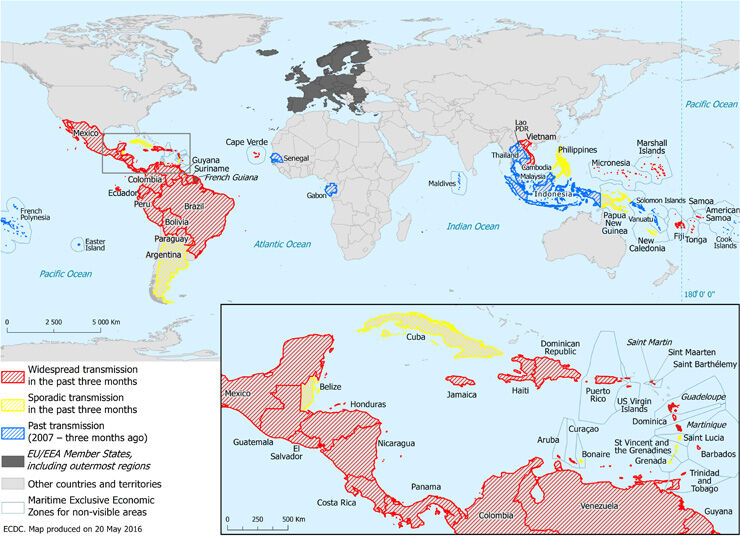Epidemiological update: Outbreaks of Zika virus and complications potentially linked to the Zika virus infection, 28 May 2016
Epidemiological update: Outbreaks of Zika virus and complications potentially linked to the Zika virus infection
New developments since the last epidemiological update published on 13 May 2016
Since the last update:
- On 13 May Puerto Rico's local health authorities reported the first possible case of microcephaly associated with locally-acquired Zika infection.
Table 1. Countries and territories with reported confirmed autochthonous cases of Zika virus infection in the past three months, as of 20 May 2016
| Countries and territories | Current Zika transmission | Zika transmission in the past nine months |
|---|---|---|
| American Samoa | Increasing or widespread transmission | Yes |
| Argentina | Sporadic transmission | Yes |
| Aruba | Increasing or widespread transmission | Yes |
| Barbados | Increasing or widespread transmission | Yes |
| Belize | Sporadic transmission | Yes |
| Bolivia | Increasing or widespread transmission | Yes |
| Bonaire | Sporadic transmission | Yes |
| Brazil | Increasing or widespread transmission | Yes |
| Cape Verde | Increasing or widespread transmission | Yes |
| Colombia | Increasing or widespread transmission | Yes |
| Costa Rica | Increasing or widespread transmission | Yes |
| Cuba | Sporadic transmission | Yes |
| Curaçao | Increasing or widespread transmission | Yes |
| Dominica | Increasing or widespread transmission | Yes |
| Dominican Republic | Increasing or widespread transmission | Yes |
| Ecuador | Increasing or widespread transmission | Yes |
| El Salvador | Increasing or widespread transmission | Yes |
| Fiji | Increasing or widespread transmission | Yes |
| French Guiana | Increasing or widespread transmission | Yes |
| Grenada | Sporadic transmission | Yes |
| Guadeloupe | Increasing or widespread transmission | Yes |
| Guatemala | Increasing or widespread transmission | Yes |
| Guyana | Increasing or widespread transmission | Yes |
| Haiti | Increasing or widespread transmission | Yes |
| Honduras | Increasing or widespread transmission | Yes |
| Jamaica | Increasing or widespread transmission | Yes |
| Marshall Islands | Increasing or widespread transmission | Yes |
| Martinique | Increasing or widespread transmission | Yes |
| Mexico | Increasing or widespread transmission | Yes |
| Micronesia, Federated States of | Increasing or widespread transmission | Yes |
| New Caledonia | Sporadic transmission | Yes |
| Nicaragua | Increasing or widespread transmission | Yes |
| Panama | Increasing or widespread transmission | Yes |
| Papua New Guinea | Sporadic transmission | Yes |
| Paraguay | Increasing or widespread transmission | Yes |
| Peru | Increasing or widespread transmission | Yes |
| Philippines | Sporadic transmission | Yes |
| Puerto Rico | Increasing or widespread transmission | Yes |
| Saint Lucia | Sporadic transmission | Yes |
| Saint Martin | Increasing or widespread transmission | Yes |
| Saint Vincent and the Grenadines | Sporadic transmission | Yes |
| Saint-Barthélemy | Increasing or widespread transmission | Yes |
| Samoa | Increasing or widespread transmission | Yes |
| Sint Maarten | Sporadic transmission | Yes |
| Suriname | Increasing or widespread transmission | Yes |
| Thailand | Historical Zika virus circulation | Yes |
| Tonga | Increasing or widespread transmission | Yes |
| Trinidad and Tobago | Increasing or widespread transmission | Yes |
| US Virgin Islands | Increasing or widespread transmission | Yes |
| Venezuela | Increasing or widespread transmission | Yes |
| Vietnam | Increasing or widespread transmission | Yes |
The classification of countries above is based on: 1) number of reported autochthonous confirmed cases; 2) number of countries who report a zika virus transmission or a country’s transmission status changes; 3) duration of the circulation.
EU/EEA and EU Outermost Regions and Territories
As of 19 May 2016, ECDC has recorded 607 imported cases in 18 EU/EEA countries. Thirty-four of the imported cases are pregnant women. In addition, one confirmed case was published following the diagnosis in a Slovenian hospital. The number of imported cases reported is not based on a systematic reporting surveillance systems hence cannot be considered exhaustive.
EU’s Outermost Regions and Territories
Martinique: As of 19 May 2016, 25 610 suspected cases have been reported, an increase of 1 770 since last week. Since the beginning of the outbreak to 19 May 2016, two microcephaly cases and one additional congenital abnormality have been reported with confirmed Zika virus infection. In addition, 20 cases with GBS have been detected. Among these, 19 have been confirmed with Zika virus infection.
French Guiana: As of 19 May 2016, 6 245 suspected cases have been reported, an increase of 485 since last week. Three cases with neurological complications have been identified since the beginning of the outbreak.
Guadeloupe: As of 19 May 2016, 5 025 suspected cases have been reported, an increase of 1 140 suspected cases since last week. One case with neurological complications has been reported since the beginning of the outbreak.
St Martin: As of 19 May 2016, 330 suspected cases have been reported, an increase of 65 suspected cases since last week. One case with neurological complications has been reported. However, an association with Zika virus infection has not been established.
St Barthélemy: As of 19 May 2016, ten suspected and one laboratory-confirmed case have been reported.
Figure 1. Countries or territories with reported confirmed autochthonous cases of Zika virus infection in the past three months, as of 20 May 2016

Figure 2. Countries and territories with reported confirmed autochthonous cases of Zika virus infection in the past nine months, as of 20 May 2016

Update on the observed increase of congenital Zika syndrome and other neurological complications
Congenital zika syndrome and GBS
As of 19 May 2016, microcephaly and other foetal malformations potentially associated with Zika virus infection or suggestive of congenital infection have been reported in eight countries (Brazil, Cape Verde, Colombia, French Polynesia, Martinique, Marshall Islands, Panama and Puerto Rico). Two additional cases, each linked to a stay in Brazil, were detected in Slovenia and the United States of America. One more case was reported in a returning traveller from the affected countries in the United States of America. One additional case was detected in Spain in a returning traveller.
In the context of Zika virus circulation, 13 countries and territories worldwide have reported an increased incidence of Guillain-Barré syndrome (GBS) and/or laboratory confirmation of a Zika virus infection among GBS cases.
Brazil: Since October 2015 and as of 14 May 2016, Brazil has reported 7 534 suspected cases of microcephaly from all states and in the Federal District. Of these cases, 1 384 are reported as confirmed cases of microcephaly, 207 of which had laboratory-confirmed presence of Zika virus infection. This is an increase of 96 suspected cases of microcephaly, and two confirmed microcephaly cases with laboratory confirmation of Zika virus infection since the last update on 7 May. Of the remaining cases, 2 818 were investigated and discarded as they did not fit the case definition, while 3 332 cases are under investigation.
Among the 7 438 suspected cases of microcephaly, 273 intrauterine or neonatal deaths were reported. Of these, 59 cases were investigated and confirmed (microcephaly or central nervous system malformations).
Colombia: Between epidemiological weeks 1 and 18 in 2016, Colombia has reported five confirmed cases of microcephaly associated with Zika virus infection, 24 cases were discarded and 43 cases were still under investigation.




